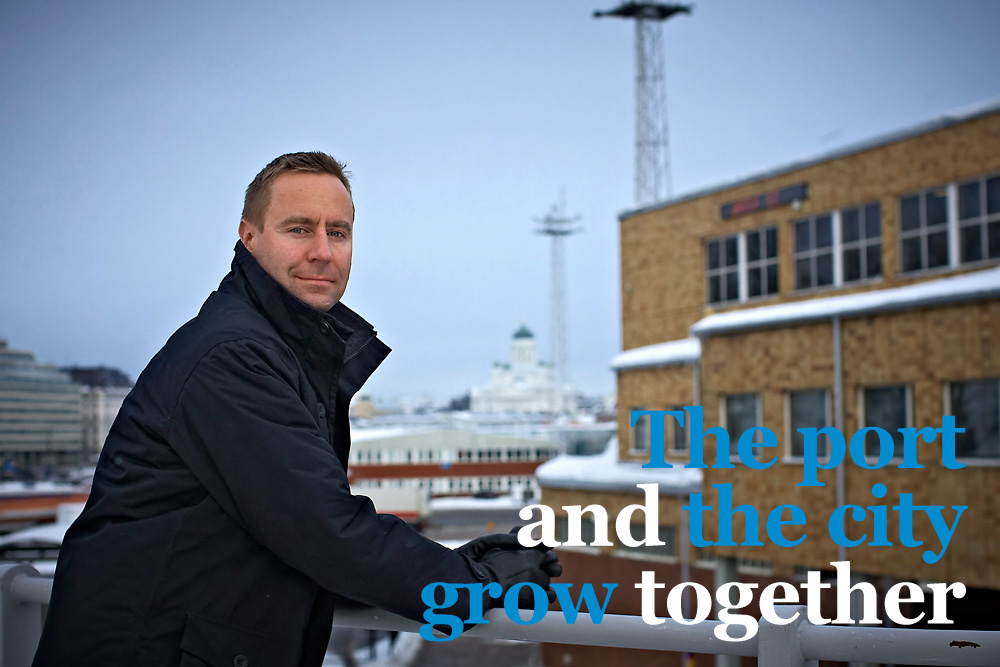
The Port of Helsinki’s Managing Director Kimmo Mäki is a seasoned logistics expert. Before taking office in 2011, he oversaw the container operations at the Helsinki and Kotka ports as a member of the management group of Steveco, Finland’s largest port operator. He had previously accrued skills in both industrial operations and the consumer business by managing logistics at the UPM-Kymmene forest-industry group and the Stockmann retail group. Photo Mari Thorin
By Johanna Lemola
Helsinki’s port and the city develop and grow together. Eyes fixed on Tallinn, the Port of Helsinki’s current focus is on the West Harbour.
Kimmo Mäki overlooks the Port of Helsinki’s iconic South Harbour from his Managing Director’s office in the historic Olympia Terminal building. The Tallink Silja Line’s Helsinki-Stockholm ferries moor just outside the building, as towering reminders of the port’s importance to the Helsinki economy. Across the harbour basin, a 50-metre-tall observation wheel will soon go up, reminding Mäki of the many forces and interests at play in the economic development of Helsinki.
“We make growth possible in the Helsinki region,” he points out, presenting impressive facts and figures of the port’s economic impact.
By value, one-third of all Finnish exports and imports pass through the port, 40 percent of the exports and imports transported by sea. Close to 11 million people pass through every year – twice the Finnish population. The port-related economy represents 5 percent of the region’s economy and 7 percent of Helsinki’s total workforce. The port’s indicators are a sensitive measure of the overall state of the global economy, as freight volumes fluctuate with demand for Finnish exports as far as in the United States and the Far East.
“Helsinki has grown around the port, and the port continues to serve as an important agent that enables further growth in the region,” Mäki says.
He declares, “My mission is to ensure the port the means to develop.” With these words he underscores his role in securing one of the economic cornerstones of Helsinki.
West Harbour at capacity
Most of the port’s passenger traffic on the regular Helsinki-Tallinn route, and all passenger traffic on the Helsinki-St Petersburg route, pass through the West Harbour, today a total of 5.5 million passengers in a year. The number is expected to grow to 6.5 million in 10 years.
The pace of activity at the West Harbour is breathtaking. The terminal is operating at full capacity. A tram line extended to the terminal a few months ago offers some relief to the high numbers of passengers on their way to and from the terminal, but cars and trucks carried by the ferries form long lines on the exit road.

At the same time, construction yards are in full swing right next to the terminal site, building the new Jätkäsaari residential district on land that used to belong to the port’s container harbour.
“Our largest ongoing task is to develop the West Harbour operations to accommodate the growing volumes,” Mäki says.
The port has plans for a second terminal to be completed in 2016-2017. The entire development project, involving new landfill and quays, added parking and upgrades to the sea channels, would continue to the 2020’s.
The harbour development project is a joint effort by the port and the Helsinki City Planning Department. “We collaborate closely to integrate the port operations and the rest of the Jätkäsaari district into a functional whole.”
Vuosaari built for the future
The Port of Helsinki took a major leap toward a sustainable future when freight operations were focused in a new and modern port in Vuosaari, eastern Helsinki, in 2008. Today only the freight carried by trucks on the Helsinki-Tallinn and Helsinki-Stockholm ferries passes through the city centre. The Vuosaari harbour meets the region’s and some national export and import needs far into the future.
“Vuosaari could easily handle a bigger share of the national flows, including some from northern Finland,” Mäki suggests, envisioning an even larger role for the harbour, which he actively promotes.
South Harbour area seeks new identity
The South Harbour area, however, seeks new definition. The City of Helsinki has made many efforts to rebuild sections of this cherished but contested heart of Helsinki – with museums including Guggenheim Helsinki, with a hotel, and now with a temporary amusement park. The City recently sought new concepts for the area with a city planning competition.
The exact identity of the South Harbour area remains to be defined, but all plans keep the harbour securely in place. “The role of the harbour here is understood very well,” Mäki says, confirming that the area’s port operations proceed in harmony with their neighbours.
Port of Helsinki’s economic impact in 2012
Value of freight passing through the port
- One-third of the value of Finnish foreign trade
- 40% of the value of Finnish exports and imports transported by sea
Port customers
- 15,000 companies active in foreign trade
- 200 stakeholder companies
Value added: €1.45 billion, 5% of the Helsinki region’s gross domestic product
- Freight operations 75%
- Passenger operations 25%
Number of employees: 24,000, 7% of Helsinki workforce
- Freight operations 54%
- Passenger operations 43%
Money left in Helsinki by passengers passing through the port: €348 million
- Passengers on regularly scheduled routes: €320 million
- Cruise passengers: €28 million
Cruise ships stand out at the port
A powerful marker of summer in Helsinki is international cruise ships. The city hosts hundreds of them over the summer season. Last year’s count was 265 ships, which carried a total of 368,000 passengers. On some days, several ships moor at the South and West Harbours allowing their passengers to explore the city, although many choose to stay onboard.
The cruise business even features large in Helsinki’s city plans and the development of the West Harbour area.
Port of Helsinki Managing Director Kimmo Mäki puts the cruise business in perspective. He points out that the international passengers carried by all ships to Helsinki left almost 350 million euro in the city last year. Less than 30 million of the sum came from cruise passengers.
“The cruise business is a fine addition to Helsinki’s economy, but the real impact comes from our regular passenger traffic,” Mäki affirms.
As he speaks on a regular winter morning, the ferries of the Tallink Silja and Viking Lines are approaching the South Harbour on their last leg of the overnight journey from Stockholm, and 10 departures and arrivals on the Helsinki-Tallinn route proceed according to their winter-time daily routine.




